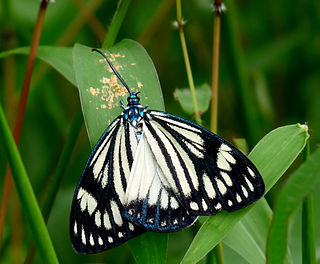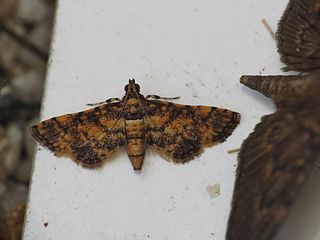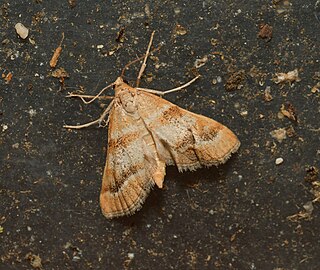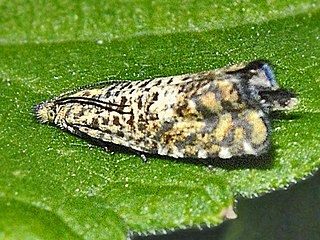
Lymantria dispar, also known as the gypsy moth or the spongy moth, is a species of moth in the family Erebidae native to Europe and Asia. Lymantria dispar is subdivided into several subspecies, with subspecies such as L. d. dispar and L. d. japonica being clearly identifiable without ambiguity. Lymantria dispar has been introduced to several continents and is now additionally found as an invasive species in Africa, North America and South America. The polyphagous larvae live on a variety of deciduous and coniferous trees and can cause severe damage in years of mass reproduction. Due to these features, Lymantria dispar is listed among the world's 100 worst invasive alien species.

Prunus spinosa, called blackthorn or sloe, is a species of flowering plant in the rose family Rosaceae. The species is native to Europe, western Asia, and regionally in northwest Africa. It is locally naturalized in New Zealand, Tasmania, and the Pacific Northwest and New England regions of the United States.

The Arctiinae are a large and diverse subfamily of moths with around 11,000 species found all over the world, including 6,000 neotropical species. This subfamily includes the groups commonly known as tiger moths, which usually have bright colours, footmen, which are usually much drabber, lichen moths, and wasp moths. Many species have "hairy" caterpillars that are popularly known as woolly bears or woolly worms. The scientific name Arctiinae refers to this hairiness. Some species within the Arctiinae have the word "tussock"' in their common names because they have been misidentified as members of the Lymantriinae subfamily based on the characteristics of the larvae.

The Zygaenidae moths are a family of Lepidoptera. The majority of zygaenids are tropical, but they are nevertheless quite well represented in temperate regions. Some of the 1000 or so species are commonly known as burnet or forester moths, often qualified by the number of spots, although other families also have 'foresters'. They are also sometimes called smoky moths.

The pine processionary is a moth of the subfamily Thaumetopoeinae in the family Notodontidae, known for the irritating hairs of its caterpillars, their processions, and the economic damage they cause in coniferous forests. The species was first described scientifically by Michael Denis and Ignaz Schiffermüller in 1775, though it was known to the ancients, with remedies described by Theophrastus, Dioscorides and Pliny the Elder. Its processionary behaviour was described in 1916 by the French entomologist Jean-Henri Fabre. It is one of the most destructive species to pines and cedars in Central Asia, North Africa and southern Europe.

Scopula immutata, the lesser cream wave, is a moth of the family Geometridae. It was described by Carl Linnaeus in his 1758 10th edition of Systema Naturae. It is found throughout Europe.

Nomophila noctuella, the rush veneer, is a species of moth of the family Crambidae.

Metasia is a genus of moths of the family Crambidae.

Metasia achroa is a species of moth of the family Crambidae described by Oswald Bertram Lower in 1903. It is known from Australia.

Metasia tiasalis is a species of moth of the family Crambidae.
Metasia carnealis is a species of moth in the family Crambidae. It is found in France, Spain, Italy, Austria, Croatia, Bosnia and Herzegovina, Romania, Bulgaria, the Republic of North Macedonia, Albania, Greece and on Sardinia and Sicily, as well as in Turkey.
Metasia gigantalis is a species of moth in the family Crambidae. It is found in Greece, the Republic of Macedonia and on Cyprus, Crete and Sicily.

Metasia corsicalis is a species of moth in the family Crambidae. It is found in France, Spain, Italy, Croatia and on Corsica, Sardinia, Sicily and Malta.

Metasia cuencalis is a species of moth in the family Crambidae. It is found in France, Spain and Portugal, as well as in North Africa, including Morocco.
Metasia hymenalis is a species of moth in the family Crambidae. It is found in France and Spain, as well as North Africa and Iran.
Metasia ibericalis is a species of moth in the family Crambidae. It is found in France, Spain and Portugal, as well as North Africa.

Metasia suppandalis is a species of crambid snout moth in the family Crambidae. It is found in southern Europe, North Africa, and southwestern Asia.
Metasia alvandalis is a moth in the family Crambidae. It was described by Hans Georg Amsel in 1961 and is found in Iran.

Steniini is a tribe of the species-rich subfamily Spilomelinae in the pyraloid moth family Crambidae. The tribe was erected by Achille Guenée in 1854.

Phiaris stibiana is a species of moth in the family Tortricidae first described by Achille Guenée in 1845. It occurs across most of Europe. It was first formally described in 1845 as Sericoris stibiana.














